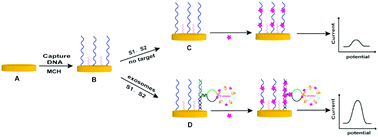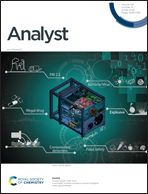A facile and label-free electrochemical aptasensor for tumour-derived extracellular vesicle detection based on the target-induced proximity hybridization of split aptamers
Abstract
Facile detection of tumour-derived extracellular vesicles (EVs) is crucial to cancer diagnosis. Herein, a facile and label-free electrochemical aptasensor was fabricated to detect tumour-derived EVs based on the target-induced proximity hybridization of split aptamers. In this assay, two designed oligonucleotide probes containing fragments of a protein tyrosine kinase-7 (PTK7) aptamer were used to recognize and capture EVs containing PTK7. In the presence of target EVs, the aptamer–target ternary complex could induce proximity hybridization and form a DNA duplex on the electrode. The DNA duplex could bind more electroactive Ru(NH3)63+ through electrostatic attraction, resulting in an increased cathodic current signal. By virtue of the excellent electrochemical signal reporter RuHex, the specificity of the aptamer and proximity ligation, a facile EV electrochemical aptasensor with a detection limit of 6.607 × 105 particles per mL was realized. Furthermore, this aptasensor showed good selectivity to distinguish different tumour-derived EVs and was applied to detect EVs in complex biological samples. The proposed electrochemical aptasensor can be further extended to the detection of other EVs, thus showing great potential in clinical diagnosis.



 Please wait while we load your content...
Please wait while we load your content...